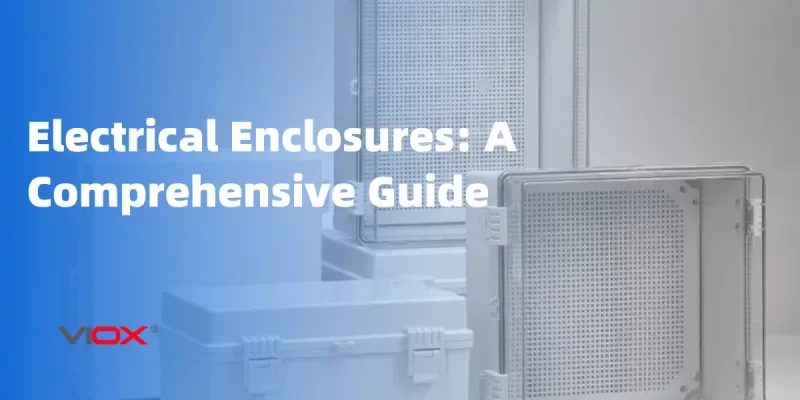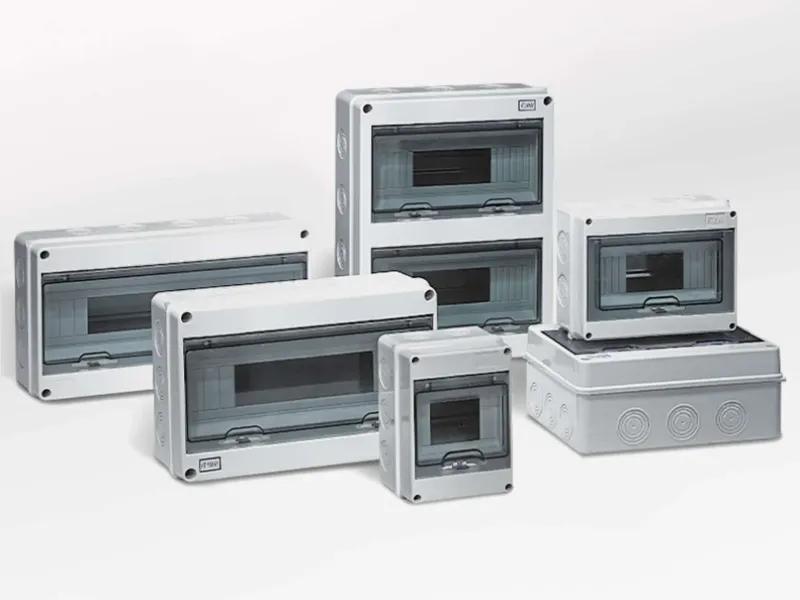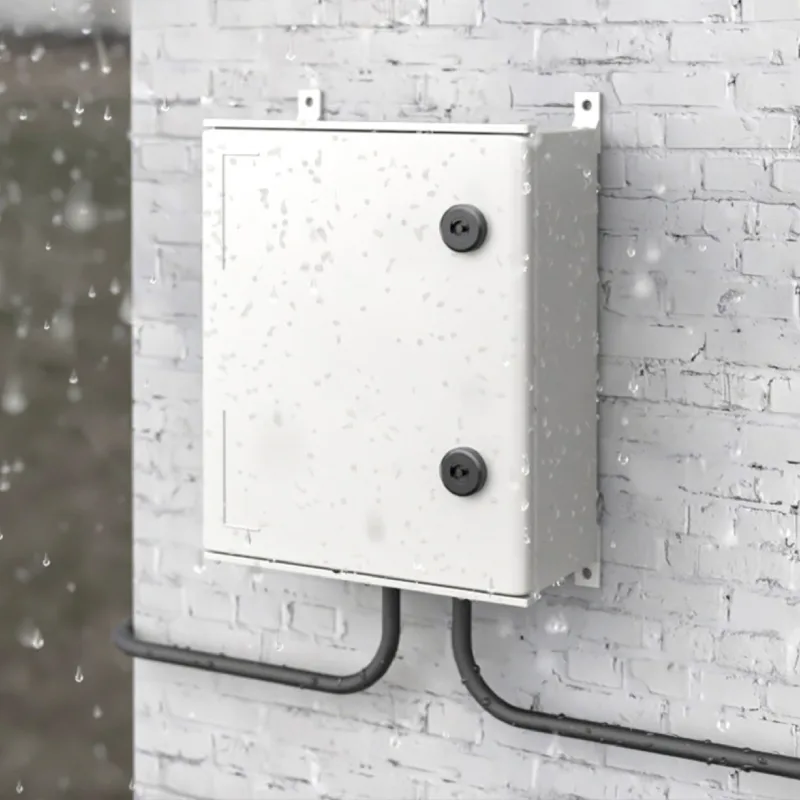An electrical enclosure is a protective housing that shields electrical components from environmental hazards, unauthorized access, and physical damage while ensuring code compliance and operational safety. Choosing the right enclosure prevents equipment failure, reduces fire risks, and meets NEC (Nacionālais elektroinstalācijas kodekss) requirements that govern electrical installations across residential, commercial, and industrial applications.
What Is an Electrical Enclosure?
An electrical enclosure is a manufactured box or cabinet designed to contain and protect electrical equipment such as slēdži, switches, transformers, and control panels. These protective housings serve three critical functions: environmental protection, safety compliance, and operational accessibility.
Key Components of Electrical Enclosures:
- Korpusa materiāls: Steel, stainless steel, aluminum, fiberglass, or plastic construction
- Sealing System: Gaskets, weatherstripping, or welded seams for environmental protection
- Access Features: Hinged doors, removable covers, or latching mechanisms
- Montāžas iespējas: Wall-mount, floor-stand, or pole-mount configurations
- Iekšējie komponenti: DIN rails, grounding bars, and component mounting systems
Types of Electrical Enclosures: Complete Comparison
NEMA Rating Classifications
| NEMA Rating | Aizsardzības līmenis | Tipiski lietojumi | Indoor/Outdoor | Galvenās funkcijas |
|---|---|---|---|---|
| NEMA 1 | General purpose | Indoor dry locations | Indoor | Basic protection from accidental contact |
| NEMA 3R | Weatherproof | Āra instalācijas | Outdoor | Rain, sleet, snow protection with drain holes |
| NEMA 4 | Watertight | Washdown areas, coastal | Both | Complete water protection, gasket seals |
| NEMA 4X | Corrosion resistant | Chemical plants, marine | Both | Stainless steel/fiberglass, chemical resistance |
| NEMA 12 | Rūpnieciskais | Manufacturing floors | Indoor | Dust, oil, coolant protection |
| NEMA 6P | Submersible | Below-grade installations | Both | Temporary submersion protection |
Material Comparison Chart
| Materiāls | Izmaksas | Izturība | Izturība pret koroziju | Svars | Labākās lietojumprogrammas |
|---|---|---|---|---|---|
| Carbon Steel | Zema | Augsts | Poor (requires coating) | Smagie | Indoor, dry environments |
| Nerūsējošais tērauds | Augsts | Ļoti augsts | Lielisks | Smagie | Chemical, marine, food processing |
| Alumīnijs | Vidēja | Augsts | Labi | Light | Outdoor, weight-sensitive applications |
| Fiberglass | Medium-High | Augsts | Lielisks | Light | Corrosive environments, coastal |
| Polikarbonāts | Low-Medium | Vidēja | Labi | Very Light | Non-metallic requirements, RF transparency |
Understanding NEMA Ratings vs IP Ratings
NEMA (Nacionālā elektroiekārtu ražotāju asociācija) vērtējumi are North American standards that specify enclosure protection levels, while IP (iekļūšanas aizsardzības) vērtējumi are international standards used globally.
NEMA to IP Conversion Reference
| NEMA Rating | Equivalent IP Rating | Protection Description |
|---|---|---|
| NEMA 1 | IP10 | Protection from >50mm objects |
| NEMA 3R | IP24 | Protection from rain and >12mm objects |
| NEMA 4 | IP65 | Dust-tight and water jet protection |
| NEMA 4X | IP65 | Dust-tight, water jet, corrosion resistant |
| NEMA 12 | IP54 | Limited dust and water splash protection |
| NEMA 6P | IP67 | Dust-tight and temporary submersion |
🔍 Expert Tip: NEMA ratings include additional performance criteria beyond IP ratings, such as corrosion resistance, construction requirements, and testing standards specific to North American conditions.
Galvenie pielietojumi un lietošanas gadījumi
Dzīvojamo ēku lietojumprogrammas
- Galvenie elektrības paneļi: NEMA 1 or 3R depending on location
- Meter bases: NEMA 3R for outdoor installation
- Pool equipment: NEMA 4X for chlorine resistance
- Outdoor outlets: NEMA 3R weatherproof boxes
Komerciālie lietojumi
- HVAC controls: NEMA 1 for indoor, NEMA 4 for rooftop units
- Lighting controls: NEMA 1 for office buildings
- Drošības sistēmas: NEMA 4 for outdoor cameras and access controls
- Fire alarm panels: NEMA 1 with specific UL certifications
Rūpnieciskie lietojumi
- Motoru vadības centri: NEMA 12 for manufacturing environments
- Process control: NEMA 4X for chemical processing
- Instrumentation: NEMA 4 for measurement and monitoring
- Enerģijas sadale: NEMA 3R for outdoor substations
How to Select the Right Electrical Enclosure
Step 1: Assess Environmental Conditions
- Atrašanās vieta: Indoor vs. outdoor installation requirements
- Mitruma iedarbība: Rain, washdown, humidity levels
- Temperatūras diapazons: Operating and storage temperature limits
- Ķīmiska iedarbība: Presence of corrosive substances
- Physical hazards: Impact, vibration, or security concerns
Step 2: Determine Size Requirements
- Component inventory: List all equipment to be housed
- Heat dissipation: Calculate thermal load and ventilation needs
- Access requirements: Service clearances and working space
- Nākotnes paplašināšanās: Allow 25% additional space for modifications
- Atbilstība kodeksam: Meet NEC Article 110.26 working space requirements
Step 3: Material Selection Criteria
Choose Stainless Steel When:
- Chemical exposure is present
- Marine or coastal environments
- Food processing applications
- Long-term corrosion resistance is critical
Choose Aluminum When:
- Weight reduction is important
- Good corrosion resistance is needed
- Cost-effectiveness is a priority
- Outdoor applications without extreme chemicals
Choose Carbon Steel When:
- Indoor, controlled environments
- Budget constraints exist
- High mechanical strength is required
- Proper coating can be maintained
Step 4: Verify Code Compliance
- NEC Article 312: Cabinets, cutout boxes, and meter socket enclosures
- NEC Article 314: Outlet, device, pull, and junction boxes
- Local amendments: Check municipal electrical codes
- UL listings: Ensure appropriate certification for application
⚠️ Drošības brīdinājums: Always consult local electrical codes and authorities having jurisdiction (AHJ) before finalizing enclosure selection. Non-compliant installations may result in safety hazards and inspection failures.
Uzstādīšanas paraugprakse
Pirmsinstalācijas plānošana
- Site survey: Verify mounting surface and accessibility
- Conduit routing: Plan entry points and cable management
- Zemējuma prasības: Ensure proper bonding provisions
- Clearance verification: Confirm working space per NEC 110.26
Uzstādīšanas process
- Mounting preparation: Level and secure mounting surface
- Enclosure positioning: Use appropriate fasteners for substrate
- Conduit connections: Install proper fittings and seals
- Grounding installation: Connect equipment grounding conductor
- Component installation: Mount equipment with proper spacing
- Final testing: Verify connections and protective systems
Biežāk pieļautās uzstādīšanas kļūdas, no kurām jāizvairās
- Inadequate sealing: Compromises NEMA rating protection
- Nepareizs zemējums: Creates safety hazards and code violations
- Overpacking: Reduces heat dissipation and accessibility
- Wrong conduit fittings: Allows moisture and contaminant entry
- Insufficient clearances: Violates NEC working space requirements
Troubleshooting Common Enclosure Problems
Moisture Intrusion Issues
Simptomi: Condensation, corrosion, equipment failure
Risinājumi:
- Verify gasket condition and proper compression
- Check drain holes for blockage (NEMA 3R enclosures)
- Install heaters or ventilation for temperature control
- Upgrade to higher NEMA rating if necessary
Pārkaršanas problēmas
Simptomi: Equipment failures, shortened component life
Risinājumi:
- Add ventilation fans or louvers
- Increase enclosure size for better heat dissipation
- Install heat exchangers for extreme conditions
- Relocate heat-generating components
Corrosion Concerns
Simptomi: Surface rust, material degradation
Risinājumi:
- Upgrade to stainless steel or aluminum
- Apply protective coatings to carbon steel
- Improve ventilation to reduce humidity
- Consider cathodic protection for buried applications
Selection Decision Matrix
Ātrās izvēles ceļvedis
| Programmas Tips | Vide | Recommended NEMA | Material Choice | Īpaši apsvērumi |
|---|---|---|---|---|
| Residential Panel | Indoor | NEMA 1 | Carbon Steel | UL Listed, proper sizing |
| Outdoor Disconnect | Exterior Wall | NEMA 3R | Aluminum/Steel | UV resistant finish |
| Baseina aprīkojums | Wet Location | NEMA 4X | Nerūsējošais tērauds | Chlorine resistance |
| Industrial Control | Factory Floor | NEMA 12 | Carbon Steel | Oil/coolant protection |
| Chemical Process | Corrosive Area | NEMA 4X | Stainless/Fiberglass | Chemical compatibility |
| Submersible Pump | Below Grade | NEMA 6P | Nerūsējošais tērauds | Temporary submersion rating |
🔧 Professional Recommendation: When in doubt between two NEMA ratings, choose the higher protection level. The additional cost is typically minimal compared to potential equipment replacement and downtime costs.
Code Compliance and Certification
Nacionālā elektroinstalācijas kodeksa (NEC) prasības
- 110.3. panta B) punkts: Equipment must be listed and labeled
- Article 312: Specific requirements for cabinets and cutout boxes
- Article 314: Junction box and conduit body regulations
- Article 110.26: Working space around electrical equipment
Required Certifications
- UL sarakstā: Underwriters Laboratories safety certification
- CSA Certification: Canadian Standards Association (if applicable)
- NRTL: Nationally Recognized Testing Laboratory approval
- Local approvals: Municipality-specific requirements
Inspection Considerations
- Verify enclosure rating matches application requirements
- Confirm proper installation and grounding
- Check working space clearances
- Validate component arrangement and labeling
Advanced Features and Options
Climate Control Systems
- Heaters: Prevent condensation in cold environments
- Fans: Provide air circulation for heat dissipation
- Air conditioning: Precision cooling for sensitive electronics
- Dehumidifiers: Control moisture in humid conditions
Security Enhancements
- Locking mechanisms: Key locks, combination locks, electronic access
- Tamper-evident seals: Detect unauthorized access
- Viewing windows: Allow status monitoring without opening
- Alarm systems: Remote monitoring of door position
Accessibility Features
- Removable panels: Easy component access
- Hinged doors: Multiple opening options
- Tool-free latches: Quick access for maintenance
- Lift-out components: Simplified service procedures
Bieži Uzdotie Jautājumi
What’s the difference between weatherproof and watertight enclosures?
Weatherproof enclosures (NEMA 3R) protect against rain, sleet, and snow but allow controlled drainage through weep holes. Watertight enclosures (NEMA 4) provide complete protection against water entry through gasket seals and are suitable for direct water exposure like washdown applications.
Can I modify an existing enclosure to achieve a higher NEMA rating?
Generally no. NEMA ratings are established through comprehensive testing of the complete enclosure system. Field modifications typically void the rating and UL listing. It’s more cost-effective to replace with an appropriately rated enclosure.
How do I calculate the required enclosure size?
Calculate based on component dimensions plus 25% expansion space, minimum wire bending radii per NEC 312.6, and working space requirements. Include thermal considerations for heat-generating equipment and ensure adequate ventilation.
What grounding requirements apply to electrical enclosures?
Per NEC 250.86, metal enclosures must be connected to the equipment grounding conductor. Non-metallic enclosures require grounding only if they contain metallic components that could become energized.
How often should enclosure seals be inspected?
Ikgadējā pārbaude is recommended for critical applications. Check gasket condition, compression, and any signs of moisture intrusion. Replace gaskets if cracked, compressed, or showing signs of deterioration.
Can different NEMA-rated components be mixed in one enclosure?
The overall enclosure protection level is limited by the lowest-rated component. All penetrations, fittings, and accessories must maintain the enclosure’s NEMA rating to preserve protection integrity.
What’s the typical lifespan of an electrical enclosure?
Carbon steel enclosures: 15-25 years with proper maintenance
Aluminum enclosures: 20-30 years in appropriate environments
Stainless steel enclosures: 25-40 years with minimal maintenance
Fiberglass enclosures: 20-35 years depending on UV exposure
Are there size limitations for different NEMA ratings?
While NEMA standards don’t specify size limits, larger enclosures face greater challenges maintaining ratings due to thermal expansion, gasket compression, and structural requirements. Custom enclosures may require special engineering and testing.
Profesionālas uzstādīšanas ieteikumi
When to Hire a Professional:
- Installations requiring electrical permits
- High-voltage applications (over 600V)
- Hazardous location installations
- Complex grounding or bonding requirements
- Custom enclosure modifications
DIY-Appropriate Applications:
- Simple replacement of existing enclosures
- Low-voltage control installations
- Basic residential panel upgrades
- Routine maintenance and inspections
🏆 Expert Insight: Electrical enclosure selection and installation directly impacts system reliability, safety, and code compliance. Investing in proper enclosure specification prevents costly equipment failures and ensures long-term operational success.
Saistīts
Sadales kārbas korpusa ražotājs





